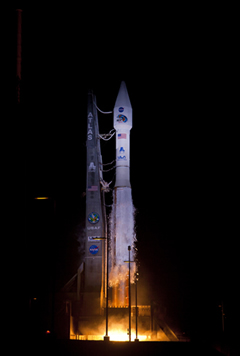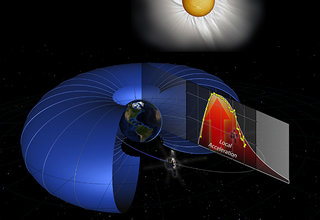April 23, 2014
Van Allen Probes Achieves Mission Success

NASA's twin Van Allen Probes launched aboard an Atlas V rocket at 4:05 a.m. EDT, Aug. 30 2012, after a smooth countdown at Cape Canaveral Air Force Station in Florida.
Credit: NASA/JHUAPL
On March 26, 2014, NASA declared the Van Allen Probes mission – designed to explore and unlock the mysteries of Earth’s radiation belts – an official success. This certification comes just one year, six months, and 27 days into the two-year primary mission of the twin spacecraft, which orbit Earth roughly every nine hours.
“Not only has the Van Allen Probes mission met its requirements for mission success, it has exceeded them,” said NASA’s Mona Kessel, Van Allen Probes program scientist. “This is where we see how all of the dedication and hard work from men and women across NASA, APL, all of the instrument teams, and our other partners that created the mission has really paid off. Already, we’ve made a number of discoveries and findings that are changing how scientists understand these fascinating regions of near-Earth space.”

Observations by NASA’s twin Van Allen Probes show that particles in the radiation belts surrounding Earth are accelerated by a local kick of energy, helping to explain how these particles reach speeds of 99 percent the speed of light. (Click the image above to view a larger image.)
Credit: G. Reeves/M. Henderson
Beginning with the discovery of a transient third radiation belt just days after the Van Allen Probes launched from Cape Canaveral Air Force Station (Fla.) on August 30, 2012, the mission has produced many findings that are altering our knowledge of the belts and how they operate. The spacecraft have revealed proven that electrons in the belt are undergoing strong local acceleration from very low frequency plasma waves, and not from an external force; discovered electric field transients called double layers that may energize the seed particle population that becomes the radiation belt population, provided data that can improve space weather models which can benefit space-based technologies and human spaceflight; and shown that persistent structures exist in the inner belt, which are caused by Earth’s rotation, a mechanism previously thought to be incapable of such an effect.
“All of these fundamental findings are, in very real ways, changing much of what we thought we knew about the radiation belts and plasma physics,” said Barry Mauk of the Johns Hopkins University Applied Physics Laboratory, Van Allen Probes project scientist. “It’s very gratifying to be able to have these incredibly accurate and sensitive instruments in orbit, and use them to produce these results. The declaration by NASA of mission success at this early stage of the mission is another laurel for all of the teams.”
“The Van Allen Probes mission is well along the route towards achieving full mission success,” said NASA’s David Sibeck, Van Allen Probes mission scientist. “Researchers within and outside the Van Allen Probes mission are accessing and interpreting the data to make fundamental discoveries concerning the processes that accelerate, transport, and cause the loss of particles within the Earth’s Van Allen Belt radiation environment.”
“The mission has passed another hurdle, but we don't stop here,” Kessel said. “There is much more data to gather, analysis to be done, understanding to be gained, and mysteries to be solved.”
NASA launched the twin Van Allen probes in the summer of 2012. APL built and operates the probes for NASA’s Science Mission Directorate. The Van Allen Probes are the second mission in NASA’s Living With a Star program, managed by NASA’s Goddard Space Flight Center in Greenbelt, MD. The program explores aspects of the connected sun-Earth system that directly affect life and society.
Media contacts: Geoff Brown, 240-228-5618, geoffrey.brown@jhuapl.edu
The Applied Physics Laboratory, a not-for-profit division of The Johns Hopkins University, meets critical national challenges through the innovative application of science and technology. For more information, visit www.jhuapl.edu.

